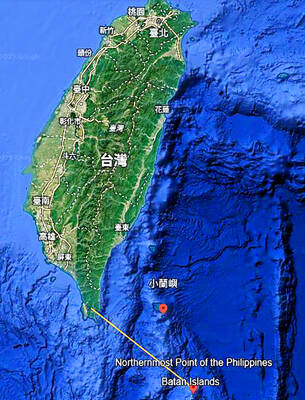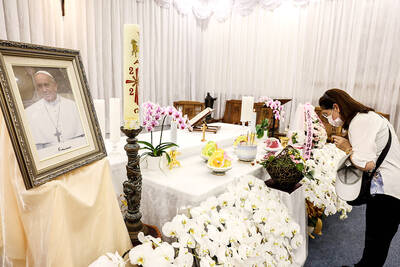Not requiring the nation’s female military reservists to attend training is not only a waste of resources, but runs contrary to gender equality, the Legislative Yuan’s Budget Center said in a report.
The government established the All-out Defense Mobilization Agency to improve the combat readiness of Taiwan’s reserve units, but has overlooked female reservists, said the report on the Ministry of National Defense’s financial statements for last year, which was released this month.
This year, the ministry began trialing a new model of educational mobilization under which military reservists must undergo two weeks of training and can be called up once a year.

Photo: Fang Pin-chao, Taipei Times
There are not enough army officers and non-commissioned officers in the reserve forces, so the military extended the period during which they can be called up from eight years to 12 years after being discharged from military service.
Female volunteers, as with their male counterparts, should according to the law be listed as reservists after being discharged from the army, the report said.
However, the current policy stipulates that female military officers and non-commissioned officers can choose not to be listed as reservists after being discharged, it said, adding that the practice contravenes the principle of equality.
Only a limited number of female officers had as of the end of last year volunteered to be listed: 487 army officers and 2,608 non-commissioned officers among 8,915 retired female military personnel, the report said.
Female military personnel receive professional training and gain practical experience during service, so should have more knowledge and skills than men who undergo mandatory military training, the report said, adding that not requiring them to attend educational mobilization makes the list “a mere formality.”
Chang Ling-ling (張玲玲), a colonel who was discharged last month and volunteered to be listed as a reservist, on Saturday said that she “had been nurtured by the armed forces during four years in military school and 30 years in the army,” so she was willing to contribute her experience and be listed.
Being mobilized in wartime without undergoing mobilization training “would be a great loss,” she said.
Regarding concerns about separating living spaces for female and male reservists, she said that it could be planned.
Military personnel are responsible, and women have been serving in the armed forces for years, she said.
Democratic Progressive Party Legislator Lin Ching-yi (林靜儀), a member of the legislature’s Foreign Affairs and National Defense Committee, on Saturday said that the ministry should consider including retired female officers in the educational mobilization program to bolster the nation’s reserve forces.
The ministry said it would assess the feasibility of including female reservists in the program based on the level of threat from enemies, the need for defensive operations and military training capacity.

SECURITY: As China is ‘reshaping’ Hong Kong’s population, Taiwan must raise the eligibility threshold for applications from Hong Kongers, Chiu Chui-cheng said When Hong Kong and Macau citizens apply for residency in Taiwan, it would be under a new category that includes a “national security observation period,” Mainland Affairs Council (MAC) Minister Chiu Chui-cheng (邱垂正) said yesterday. President William Lai (賴清德) on March 13 announced 17 strategies to counter China’s aggression toward Taiwan, including incorporating national security considerations into the review process for residency applications from Hong Kong and Macau citizens. The situation in Hong Kong is constantly changing, Chiu said to media yesterday on the sidelines of the Taipei Technology Run hosted by the Taipei Neihu Technology Park Development Association. With

CARROT AND STICK: While unrelenting in its military threats, China attracted nearly 40,000 Taiwanese to over 400 business events last year Nearly 40,000 Taiwanese last year joined industry events in China, such as conferences and trade fairs, supported by the Chinese government, a study showed yesterday, as Beijing ramps up a charm offensive toward Taipei alongside military pressure. China has long taken a carrot-and-stick approach to Taiwan, threatening it with the prospect of military action while reaching out to those it believes are amenable to Beijing’s point of view. Taiwanese security officials are wary of what they see as Beijing’s influence campaigns to sway public opinion after Taipei and Beijing gradually resumed travel links halted by the COVID-19 pandemic, but the scale of

A US Marine Corps regiment equipped with Naval Strike Missiles (NSM) is set to participate in the upcoming Balikatan 25 exercise in the Luzon Strait, marking the system’s first-ever deployment in the Philippines. US and Philippine officials have separately confirmed that the Navy Marine Expeditionary Ship Interdiction System (NMESIS) — the mobile launch platform for the Naval Strike Missile — would take part in the joint exercise. The missiles are being deployed to “a strategic first island chain chokepoint” in the waters between Taiwan proper and the Philippines, US-based Naval News reported. “The Luzon Strait and Bashi Channel represent a critical access

Pope Francis is be laid to rest on Saturday after lying in state for three days in St Peter’s Basilica, where the faithful are expected to flock to pay their respects to history’s first Latin American pontiff. The cardinals met yesterday in the Vatican’s synod hall to chart the next steps before a conclave begins to choose Francis’ successor, as condolences poured in from around the world. According to current norms, the conclave must begin between May 5 and 10. The cardinals set the funeral for Saturday at 10am in St Peter’s Square, to be celebrated by the dean of the College